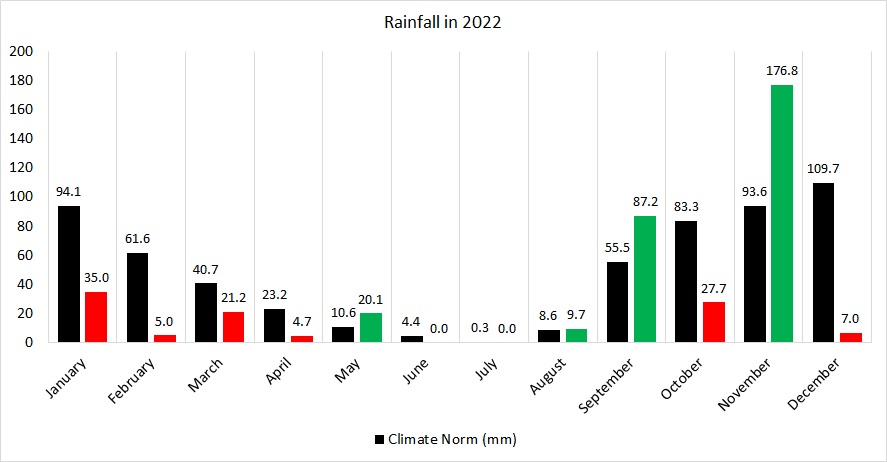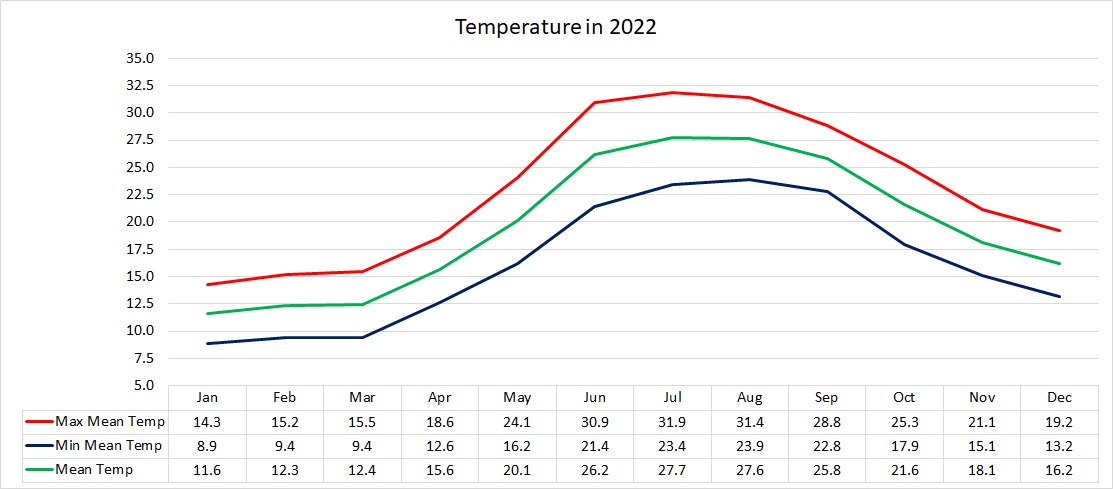Sweltering in July 2023
Air Temperature
| Highest Maximum | 39.8°C | 24th |
| Lowest Maximum | 26.8°C | 3rd |
| Highest Minimum | 28.5°C | 25th |
| Lowest Minimum | 19.8°C | 14th |
| Mean Maximum | 32.9°C |
| Mean Minimum | 23.4°C |
| Mean | 28.2°C |
Relative Humidity
| Highest Relative Humidity | 94% | Numerous days |
| Lowest Relative Humidity | 13% | 21st |
| Mean Relative Humidity | 68.9% |
Wind
| Highest Gust | 54.7km/h | 26th |
| Mean Wind Speed | 8.5km/h |
| Most Frequent Wind Direction | South |
Atmospheric Pressure
| Highest Atmospheric Pressure | 1020.2hPa | 8th and 10th |
| Lowest Atmospheric Pressure | 1009.8hPa | 25th |
| Mean Atmospheric Pressure | 1016.1hPa |
Precipitation
| Total Rainfall During July 2023 | 0.0 mm |
| Total Rainfall Since Last 01/09 | 576.6 mm |
| Highest 24 Hour Total | 0.0 mm | / |
| Rain Days | 0 days |
| Thunderstorm Days | 0 days |
| Hail Days | 0 days |
July 2023 Compared to the Climate Means
| Climate Mean | July 2023 | Anomaly | |
| Mean Maximum Temperature | 31.5°C | 32.9°C | +1.4°C |
| Mean Minimum Temperature | 22.4°C | 23.4°C | +1.0°C |
| Mean Temperature | 27.0°C | 28.2°C | +1.2°C |
| Mean Relative Humidity | 70.6% | 68.9% | -1.7% |
| Mean Atmospheric Pressure | 1014.6hPa | 1016.1hPa | +1.5hPa |
| Total Rainfall | 0.2 mm | 0.0 mm | -0.2 mm |
| Total Rainfall Since Last 01/09 | 520.5 mm | 576.6 mm | +56.1 mm |
| Total Rain Days | 0 days | 0 days | / |
| Total Thunderstorm Days | 0 days | 0 days | / |
| Total Hail Days | 0 days | 0 days | / |
Sweltering in July 2023
The first few days of July 2023 continued where June left off. It didn’t take long for this state of affairs to change, however.
The mean temperature of 28.2°C, registered at our weather station in Għarb, exceeded the norm by 1.2°C. The mean maximum temperature of 32.9°C surpassed the norm by 1.4°C. The mean minimum temperature of 23.4°C, on the other hand, stood a full 1°C above the norm. Being the smaller island and under a stronger moderating effect of the sea, Gozo was spared the worst of the heat. Temperature values measured in Malta painted a far more worrying picture. Mean temperatures there were overall a staggering 3.5°C over the climate average. This made it officially the hottest July on record.
Using the national criteria for a heatwave, we conclude that the Maltese Islands experienced one heatwave last month. Lasting from 16th July through to 25th July (both days included), it proved to be record-breaking too. Whilst the temperature peaked at 39.8°C across Gozo, the maximum temperature across central Malta spiked to 42.7°C on the 24th. This was the joint hottest temperature measured during July along with the record set back on 9th July 1988. A deeper look into readings from central Malta show how the air temperature exceeded 40°C on a record-breaking six consecutive days. These are 41.0°C on the 20th, 40.2°C on the 21st, 41.1°C on the 22nd, 42.3°C on the 23rd, 42.7°C on the 24th and 40.0°C on the 25th. July’s long-lasting heat wave also broke the record for the warmest night. The minimum temperature on the night between the 24th and 25th remained at a hot 30.6°C at the airport. The value in Għarb on the night was of 28.5°C.
July 2023 also lived up to its expectation of being a completely dry month. No rain made it to the Maltese Islands throughout. Some mist or fog patches were observed prior to and during the heat wave.
The wind only reached Force 6 or stronger on two days, one at the beginning and the other towards the end. The highest wind gusts, at 54.7km/h (Force 7), was recorded on the 26th.

Rainfall Totals around the Maltese Islands in July 2023 (and since last September 1st):
Għarb: 0.0 mm (576.6 mm)
Victoria: 0.0 mm (508.2 mm)
Xewkija: 0.0 mm (505.2 mm)
Nadur: 0.0 mm (505.8 mm)
Marsalforn: 0.0 mm (533.4 mm)
Mellieħa: 0.0 mm (473.1 mm)
Buġibba: 0.0 mm (551.7 mm)
Mġarr: 0.0 mm (509.3 mm)
Naxxar: 0.0 mm (649.7 mm)
Mosta: 0.0 mm (617.0 mm)
Dingli: 0.0 mm (537.2 mm)
Msida: 0.0 mm (704.8 mm)
Valletta: 0.0 mm (528.5 mm)
Imqabba: 0.0 mm (587.8 mm)
Żabbar: 0.0 mm (583.2 mm)
Birżebbuġa: 0.0 mm (486.3 mm)
Sliema: 0.0 (676.3 mm)
NATIONAL MEAN: 0.0 mm (560.8 mm)













